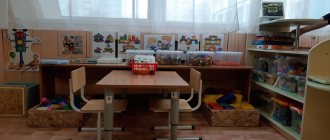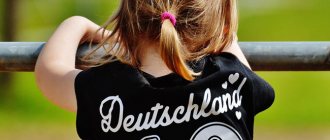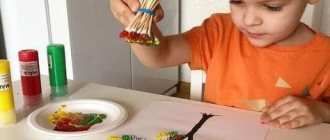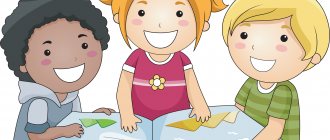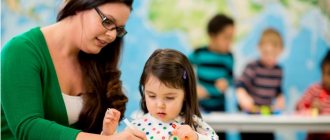Development of preschool children in the process of mastering paper construction techniques
Diverse development of children in the process of mastering paper construction techniques
Author: Elena Viktorovna Maltseva, teacher at MBDOU No. 186, Rostov-on-Don. Description : The role of productive activity in the development of a child cannot be overestimated. It promotes the comprehensive development of preschool children (develops imagination, fine motor skills, coordination of movements, develops mental operations, promotes the acquisition of many practical skills necessary to perform a variety of jobs...), in addition, it reflects the child’s inner world, his aspirations, desires and experiences. I offer you a series of simple crafts for “beginning creators”. This material may be of interest to preschool teachers and parents of preschool children. The goals of the teacher (parent): creating situations that stimulate the activity of children and encourage them to develop productive activities. Child’s goal : Development of creative abilities and accumulation of successful experience in the child’s productive activities. Objectives: Educational: 1. Formation of elementary geometric concepts (flat and three-dimensional figures, their basic properties). 2. Formation of the ability to follow the teacher’s oral instructions. 3. Training in various techniques for working with paper. 4. Enriching the child’s vocabulary with special terms. 5. Formation of skills to perform precise movements with fingers. Developmental: 1. Development of fine motor skills of the hands. 2. Development of mental processes (attention, memory, imagination, thinking). 3. Eye training. 4. Development of artistic taste. 5. Development of fantasy. 6. Expanding the interests of the child. Educational: 1. Formation of moral qualities: hard work and independence. 2. Formation of a work culture (teach accuracy, the ability to use materials carefully and economically, keep the workplace in order, and clean up after oneself). 3. Accumulation of labor skills. 4. Formation of the habit of finishing what you start. 5. Formation of the habit of evaluating the results of your work. The difficulty of engaging in productive activities with preschoolers is that they have very little skills and knowledge in this area, on the one hand, but on the other hand, it is very important for the child to gain a positive experience in creativity. The teacher is faced with the task of gradually teaching children the techniques of working from activities and designing in various techniques and, at the same time, preventing the child from having a negative experience in creativity in order to avoid future refusal of productive activities. To do this, it is necessary to select interesting jobs that the child can definitely handle (accumulation of positive experience), and gradually increase the complexity. Children should also be taught not to allow ridicule and incorrect statements about other people’s work. Everyone “creates” in their own way, and all works are unique. In this work I want to talk about paper construction. The necessary materials used by children must be safe and comfortable. • It is better to take small scissors with comfortable ears for your fingers and rounded ends; • The glue must not have a strong odor. If children work with PVA glue, then it will be more convenient for them to distribute the glue over the surface of the product with a brush; • You need paper of different sizes and thicknesses; • Decorative items should not leave traces of paint on your hands or have a strong odor. Designing from paper can be divided into 3 stages: • designing a sample; • design according to form; • designing according to a theme or design. In any technique, it is better to start working with preschoolers by designing according to a model. The teacher invites the children to examine the finished craft (sample), compare it with the proposed parts, and gives instructions on how to make it. By mastering this simplest type of construction, children learn to repeat an object (drawing) they see and assemble a whole from parts. In addition, they learn how to work with glue and scissors. At the next stage, the child is offered blanks, but the teacher shows several different options for the craft at once and does not give instructions for implementation. The preschooler must assemble the desired composition himself from the proposed parts. At the end, all works are hung next to the samples, the diversity and individuality of the crafts is noted. A child with some experience in design is able, by showing imagination, to work on a given topic independently. It is very important for the teacher to identify what to praise the child for (he coped with the task, chose the material well, completed the work carefully...) There are many techniques for constructing from paper, for example: quilling, origami, origami from circles, modular origami, “wet folding” origami, parchment , katagami, collage, scrapbooking (English: “scrapbook book”), corrugated tubes, embossing (another name for “embossing”), kirigami, kusudama (Japanese: “medicine ball”), papier mache, decoupage, trimming, paper art, iris folding (“rainbow folding”), paper plastic, paper sculpture, techniques related to weaving... (I don’t post works in these techniques from the Internet, according to the terms of the competition, you can easily find them yourself). There is something to interest children... all that remains is to teach the necessary skills and techniques. I started with the origami technique, but I was faced with the fact that it was difficult for children to fold paper evenly and neatly. We started practicing on crafts with an accordion. The children are happy, they have mastered the technique of folding paper into an accordion. That's what we did. The first work is “Birds Are Small.”
I cut out the silhouette of a bird from double-sided colored paper, and the children finished drawing everything that their pets should have. For the wings we made an “accordion” from paper of a different color (approximately 16cm*16cm). It is better to make the width of the “accordion” no more than 10-15 mm. In the place where the wings should be, cut a hole the size of an accordion.
We insert the wings, hang them on a ribbon and you can check how our pet flies...
Then they made a bigger bird - PEACOCK
She drew and cut out the body of a peacock, gave it to the weaker children, the rest drew the nose, eyes themselves... The tail was made from the same “accordion”. We took two sheets of colored paper of the color we wanted. The wide sides of the paper were folded into an accordion. Then we glued two accordions together, folded them into a fan, and glued the middle. The tail is ready. You can cut the ends of the fan diagonally, you can decorate it in your own way.
I offered the following birds only to those interested...
The children made me happy; everyone worked hard. The birds were made from two fans, which were glued together. Glued eyes, wings, tail. When everything was dry, we taped the skewer in two places. Almost all children have mastered the technique of folding paper into an accordion in the forward direction. Most are already on the second bird. Then we mastered the technique of folding the paper into an “accordion” diagonally on “Butterflies” and “Leaves”
We recommend watching:
Games with paper for preschool children Development of fine motor skills in preschool children Sensorimotor development of preschoolers Development of fine motor skills with household items
Similar articles:
Summary of joint activities in a senior speech therapy group on the development of fine motor skills of the hands
Finger games for older preschoolers
